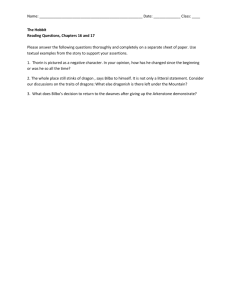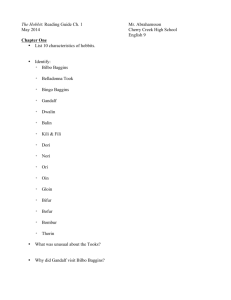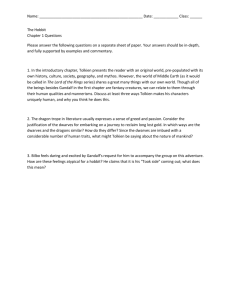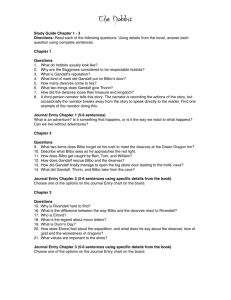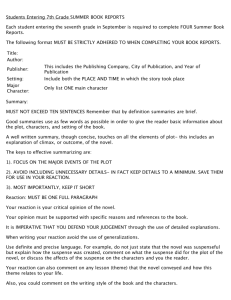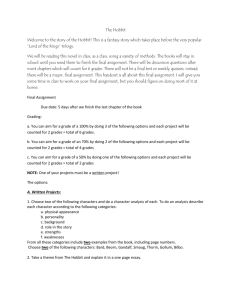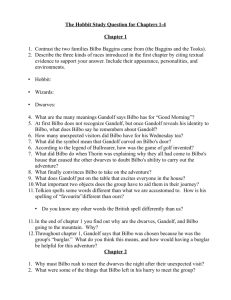Honors Summer Reading, Grade 10
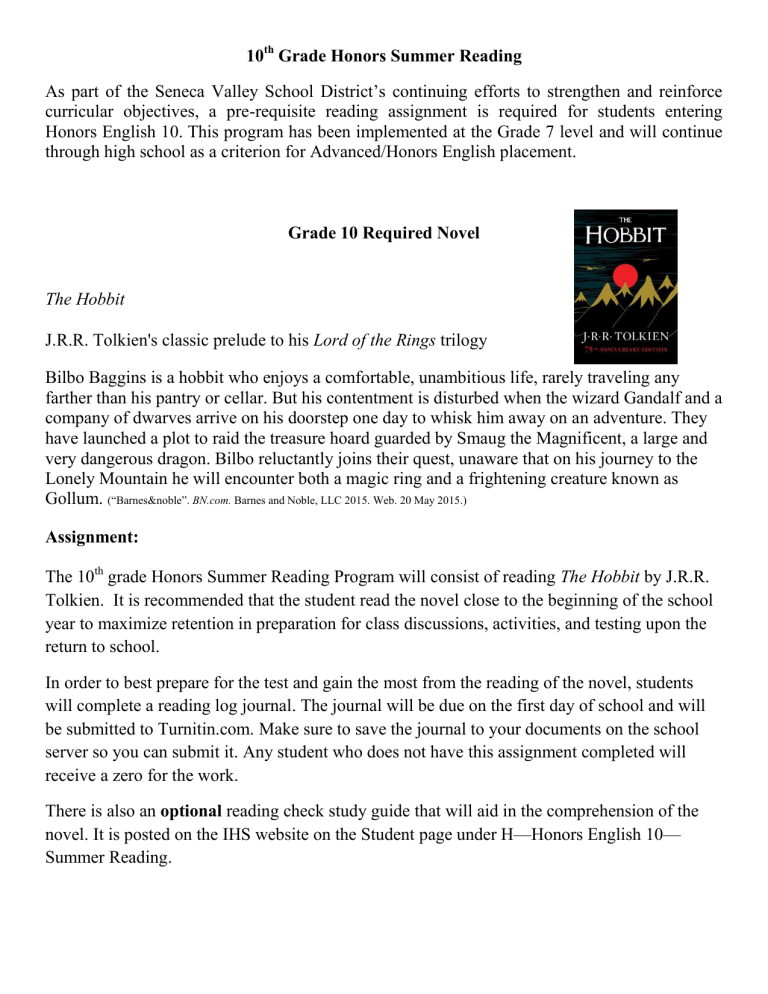
10 th
Grade Honors Summer Reading
As part of the Seneca Valley School District’s continuing efforts to strengthen and reinforce curricular objectives, a pre-requisite reading assignment is required for students entering
Honors English 10. This program has been implemented at the Grade 7 level and will continue through high school as a criterion for Advanced/Honors English placement.
Grade 10 Required Novel
The Hobbit
J.R.R. Tolkien's classic prelude to his Lord of the Rings trilogy
Bilbo Baggins is a hobbit who enjoys a comfortable, unambitious life, rarely traveling any farther than his pantry or cellar. But his contentment is disturbed when the wizard Gandalf and a company of dwarves arrive on his doorstep one day to whisk him away on an adventure. They have launched a plot to raid the treasure hoard guarded by Smaug the Magnificent, a large and very dangerous dragon. Bilbo reluctantly joins their quest, unaware that on his journey to the
Lonely Mountain he will encounter both a magic ring and a frightening creature known as
Gollum.
(“Barnes&noble”. BN.com.
Barnes and Noble, LLC 2015. Web. 20 May 2015.)
Assignment:
The 10 th
grade Honors Summer Reading Program will consist of reading The Hobbit by J.R.R.
Tolkien. It is recommended that the student read the novel close to the beginning of the school year to maximize retention in preparation for class discussions, activities, and testing upon the return to school.
In order to best prepare for the test and gain the most from the reading of the novel, students will complete a reading log journal. The journal will be due on the first day of school and will be submitted to Turnitin.com. Make sure to save the journal to your documents on the school server so you can submit it. Any student who does not have this assignment completed will receive a zero for the work.
There is also an optional reading check study guide that will aid in the comprehension of the novel. It is posted on the IHS website on the Student page under H—Honors English 10—
Summer Reading.
The Hobbit
Reading Log Journal
A reading log journal requires you to choose quotes from the novel you are reading, and then reflect upon the quotes. As you are reading, you may want to use Post-it notes to mark where you may have questions or comments on events, people, quotations, or anything that you find interesting or unusual. You can then respond to these in your journal. Create a typed reading log of 19 entries (one from each chapter) that focuses on the Essential Questions , theme, events, and characters of the novel. Number your responses and i nclude the page # of the quote for reference.
The responses are to be your own original work and will be submitted to
Turnitin.com on the first day of school.
On the left side , copy a meaningful passage from that chapter - perhaps a bit of dialogue, a description, or a character’s thought. Be sure to label your entries and include the page number from which you copied it. These quotes should be a substantial length of three to four sentences.
On the right side, write your response to the quotation. It should answer one or more of the following questions. o Make a connection with your own experience. What does the reading make you think of? Does it remind you of anything or anyone? o Make connections with other texts, concepts, or ideas you are familiar with. Do you see any similarities between these and other information? Can you make a literary connection? o Ask yourself questions about what you are reading. “I wonder why…” or “I don’t understand…” or “I was surprised by…” o Try agreeing with the writer and write down supporting ideas. Try arguing – on what points do you disagree? o Write down literary devices, images, phrases. Why did the author choose these?
What do they add to the story? What made you notice them? o Each response should consist of 2-4 sentences.
Do not just “translate” each quote. In other words, if the quote says, “The sky was cerulean,” don’t just say, “This means the sky was blue.”
Reading Log Journal Example
This is an example of a reading log journal for the novel Pride and Prejudice .
To create the journal, open a Word Document, select Insert, select table, and create a page with two columns and 20 rows. Label the first column, first row— Chapter Quote ; label the second column, first row— Reflection .
Reflection Chapter Quote
1. (pg. 1) “It is a truth universally acknowledged that a single man in possession of a good fortune must be in want of a wife.”
This is the first sentence of the book. When I first read it I thought the writer was serious—it seemed like something people might have believed when it was written. Soon I realized she was making fun of that attitude. I saw the movie Pride and Prejudice , but it didn’t have a lot of funny parts, so I didn’t expect the book to be funny at all.
First of all, I didn’t think that a woman could be
“handsome.” I also thought it was strange that he is rejecting Elizabeth right off the bat. I really don’t like Mr.
Darcy at all because he thinks he is too good for her and is an arrogant snob.
2. ( pg. 34) “
She is tolerable, I suppose, but not handsome enough to tempt me; I am in no humour at present to give consequence to young ladies who are slighted by other men. You had better return to your partner and enjoy her smiles, for you are wasting your time with me.”
3 . (pg. 57) “ Vanity and pride are different things, though the words are often used synonymously. A person may be proud without being vain. Pride relates more to our opinion of ourselves, vanity to what we would have others think of us.”
There are many uses of the word “pride” in the novel so far.
This is interesting because it is the title of the novel. I feel as if I am not often proud of myself and I really need to work on that. Sometimes I focus too much on what other people think of me.
Essential Questions for The Hobbit
Consider the following Essential Questions as you are reading The Hobbit and responding in your reading log.
1.
How can a person’s decisions and actions change his/her life?
2.
How does Bilbo’s moral code emerge over the course of The Hobbit?
What key evidence in the novel gives us insight into Bilbo’s particular definition of right and wrong?
3.
Consider some of the moral problems that Tolkien identifies with the dwarves, their quest, and their treatment of Bilbo. What assessments can we make regarding the dwarves overcoming these moral challenges?
4.
How did greed affect the characters? What part does wealth and materialism play in the novel?
5.
What can the reader infer about Gandalf’s sense of good and evil?
6.
How does luck and magic, and also fate and prophecy play a role in the novel?
7.
Are there universal themes in literature that are of interest or concern to all cultures and societies?
8.
Do the attributes of a hero remain the same over time?
9.
In the face of adversity, what causes some individuals to prevail while others fail?
10.
How do archetypes inform our understanding of literature and the world?
11. How are the hero, his/her quest, and his/her ideals still valid and useful in today’s world?
The Hobbit
By: J.R.R. Tolkien
In the fantasy world of Middle-earth, J.R.R. Tolkien has created many echoes of the "real" world. Familiar human traits, both good and bad, abound in the actions of the hobbits, elves, dwarves, goblins, wizards, necromancers, dragons, and other more unusual inhabitants of this world. In his essay "On Fairy Stories," Tolkien states that one of the major values of stories about the Perilous Realm of Faerie is that such stories provide opportunities for regaining a clearer perspective on the real world. While the adventure story is an entertaining, well-constructed narrative, it is also an appreciation of the simple things in life—good and regular meals, comfortable homes, songs and traditions, and the joys of friendship. In
The Hobbit an unlikely hero learns that courage, honesty, and imagination count far more than physical power.
Much of the evil that the forces of good must overcome in Middle-earth is embodied in fantastic beings: a dragon, trolls, goblins, and monstrous spiders. The kind of evil that they represent, especially greed and destructive malice, is, however, familiar to all readers, children or adults. The strongest lesson about the insidious nature of evil lies in the way in which a good dwarf, Thorin, yields to greed and almost destroys his friends. It is Bilbo's willingness to give up the wealth to which he has a right, combined with his sense of responsibility for his friends that keeps forces for good from destroying one another and allows them to unite against common enemies. Although Tolkien never implies that his fantasy world can be completely freed from evil, he shows clearly that good is attainable by the individual who really works for it, whether that individual is a strong character like the wizard Gandalf or a diminutive, timid hobbit like Bilbo
Baggins.
Main Characters:
Bilbo Baggins – A short, peaceful hobbit, Bilbo Baggins is the protagonist of the novel. He considers himself a typical hobbit; that is, until Gandalf and the dwarves appear at his door.
Although he initially hesitates, Bilbo joins the adventure to find the stolen treasure.
Gandalf – A mighty wizard, Gandalf convinces the dwarves to recruit Bilbo Baggins for the adventure to reclaim the treasure. Ageless and wise, he alone recognizes the potential greatness in Bilbo. Gandalf is also brave. He tends to appear at the most opportune moments and is familiar with all aspects of Middle-earth.
Thorin Oakenshield – Thorin is the brave leader of a band of thirteen dwarves. His grandfather was the King under the
Mountain until Smaug drove the dwarves away and destroyed the human city of Dale. At the start of the novel he seeks to reclaim the treasure of his ancestors and take his throne.
Smaug – Smaug is a wicked, fire-breathing dragon. He is extremely powerful, intelligent, and cruel. Years before, he destroyed the peaceful, wealthy community of dwarves under the Lonely Mountain and the human city of Dale. The dwarves and humans were trading partners and enjoyed a friendly relationship. The human survivors built Esgaroth, a town in the middle of the Long Lake.
Gollum - Gollum is a slimy, lizard-like creature living on a rock in the middle of a cold lake underneath the Misty
Mountains. He possesses the powerful ring of invisibility. (How it came into his possession is revealed in Lord of the
Rings).
Bard – The grim human who is the honorable captain of the guard in Lake Town, a human city built on Long Lake just south of the Lonely Mountain.
Elrond – The great leader of the elves at Rivendell.
Races of Characters :
Dwarves – Thorin’s group composed of 13 dwarves, none of whom is really developed as an individual character in the novel. The narrator describes dwarves unfavorably in Chapter 12, noting their greed and trickery. Some however are descent enough people if you don’t expect too much.
Elves – The first creatures in Middle-Earth. Immortal unless killed in battle, they are fair-faced, with beautiful voices, and have a close communion with nature, which makes them wonderful craftsmen. There are actually two different varieties of elves: the wood elves and the high elves. The wood elves reside in Mirkwood and, as a result, have more suspicious and less-wise tendencies than their high relatives.
Hobbits – Bilbo’s race, as described above.
Humans – Humans appear in the settlement of Lake Town near the Lonely Mountain. Tolkein emphasizes their mortality, their lack of wisdom, their discordance with nature, and their rampant feuding, but he does not describe humans as inherently evil in the same way that he characterizes goblins and Wargs.
Trolls – Short-tempered and dull-witted creatures that will eat just about anything, Tolkien has them speak with a cockney accent, the dialect of lower-class Londoners.
Goblins – Evil creatures encountered by Bilbo and his companions. Goblins are infamous for their ability to make cruel weapons and torture devices.
Wargs – Evil wolves that join forces with the Goblins at the Battle of the Five Armies. The Wargs haunt and pursue Bilbo and the dwarves soon after Bilbo acquires the ring.
Places:
The Shire (Hobbiton) – The place where the hobbits live. A cozy town full of warm, inviting hobbit holes, including Bag
End, the home of Bilbo Baggins.
Rivendell – The home of the high elves.
The Lonely Mountain – Where Smaug has made his home. Formerly under the rule of the Dwarves, Smaug came in and chased everyone out.
Mirkwood – The forest near the Lonely Mountain where the wood elves and many strange things live.
Esgaroth – The town near the Lonely Mountain where the humans live.
Themes
The War between Good and Evil
Luck and Magic—Fate and Chance (Tolkien recognized prophecy and fate as core elements of mythology)
The quest for heroic stature
Greed and its effects
Study guide questions:
Introduction:
1. What are runes?
2. Explain the difference between a goblin and a hobgoblin.
Chapter One
1. Who is Bilbo Baggins? Give a brief description of a hobbit.
2. Discuss the significance of the name Belladonna.
3. What does Gandalf do to Bilbo’s door and who begins to arrive at Bilbo’s home the next day?
4. What story did the dwarves’ song tell?
5. What indication is there that Thorin is the leader of the dwarves?
6. What does Gandalf threaten to do if the assembled dwarves refuse to accept his choice of Bilbo Baggins as the fourteenth man for their expedition?
7. According to Thorin, what happened to his family’s wealth?
8. Why does Gandalf choose Bilbo to be a part of this adventure?
9. Why does Bilbo choose to be a part of this adventure?
Chapter Two
1. When Bilbo woke the next day, what evidence is there that he hasn’t just been dreaming about a party?
2. What indication is there in the note left by Thorin and Company that the adventure or quest may prove to be perilous for
Bilbo?
3. Who do the dwarves notice has gone missing?
4. What does Bilbo see as he approaches the red light?
5. What happens to the dwarves as they come to Bilbo’s aid?
6. How does Gandalf use his powers?
7. What happened to the trolls? Who caused it? How?
8. What did Thorin and Gandalf take from the cave?
Chapter Three
1. According to Gandalf, what lay hidden somewhere not too far ahead of the travelers?
2. Who owned the Last Homely House? How long did they stay there?
3. Where did the swords they took from the trolls come from?
4. What did the markings on the map say and what is the importance of moon letters?
5. What makes the swords so important in the story?
6. Why is it important that Bilbo’s sword is unnamed?
Chapter Four
1. Explain how the dwarves and the hobbit were able to find their way up the treacherous mountain.
2. What did Tolkien mean by a thunder-battle?
3. Describe what the stone-giants were doing.
4. What indication is there that the cave might not be safe?
5. Why was it fortunate that Bilbo had accompanied the dwarves into the cave?
6. Explain how the ponies disappeared.
7. Why were the Goblins so upset when they saw Thorin’s sword?
8. Who came to the rescue of the dwarves and what weapon did they use?
9. What happens to Bilbo at the end of the chapter?
Chapter Five
1. When he awoke, why was Bilbo so frightened?
2. What does Bilbo find as he crawls blindly along the floor of the tunnel?
3. Why is Bilbo comforted by his little sword?
4. Who is Gollum and where does he live?
5. What game did Bilbo play with Gollum and what were the stakes?
6. Explain the power of Gollum’s ring?
7. How did Bilbo escape Gollum?
8. What two things did Bilbo learn from Gollum?
9. Why are the goblins reluctant to pursue Bilbo once he is outside?
Chapter Six
1. When Bilbo finds Gandalf and the dwarves, what were they arguing about?
2. By being inside the mountain, what had they accomplished?
3. What danger did they face on the Edge of the Wild? Where did they find safety?
4. Why were the Wargs all meeting together? Who were their allies? Why did they distrust Bilbo’s party?
5. How did Gandalf get the Wargs to leave?
6. What did the Wargs and the Goblins plan to do to Bilbo’s party?
7. Who rescued them? Why?
8. Explain the significance of the title of this chapter.
9. Why does Bilbo lie? Why does Gandalf not say anything?
Chapter Seven
1. After the Eagles safely took the party east of the mountain, why does Gandalf plan to leave them?
2. According to Gandalf, what are two possibilities explaining the origin of Beorn?
3. How does Gandalf prove himself to be a great manipulator when he is talking to Beorn?
4. What information did Beorn glean in his travels to the wolf-glade?
5. What gruesome sight did Beorn reveal to the adventurers when asked by Bilbo what had happened to the captured wolf and goblin?
6. What warning does Beorn give the travelers about proceeding through Mirkwood?
7. What were Gandalf’s final cautionary words as he bade farewell to the dwarves and Bilbo?
8. Why did the party not go around the forest?
9. What dangers were behind the party? What dangers lie ahead?
Chapter Eight
1. At night in the Mirkwood Forest, what was the only thing they saw?
2. Why were the travelers unable to cross over the stream by bridge?
3. Explain how Bombur’s unfortunate incident slowed their travels?
4. Why did Bilbo and dwarves stray from the path?
5. What did Bilbo discover was happening to him when he awoke?
6. Explain the transformation of Bilbo Baggins’ character as he renames his sword Sting?
7. Why is Bilbo horrified when he stumbles upon the dwarves in a dark part of the Mirkwood forest?
8. Explain why Bilbo is so adroit at throwing stones.
9. How is Bilbo able to rescue the dwarves?
10. What secret did Bilbo tell?
11. What happened to Thorin? How was he treated?
12. How is Bilbo starting to seem like a hero?
Chapter Nine
1. Where did the Wood-elves take their captives?
2. How did the dwarves react to their interrogation by the Elvenking?
3. What does the Elvenking order his men to do?
4. How does Bilbo learn that Thorin was being kept captive in the dungeon? What message from Thorin did Bilbo pass on?
5. What alternative exit did Bilbo find? What was it used for?
6. What was Bilbo’s plan? What was the fault in the plan?
7. What did the elves’ song give to Bilbo?
8. How did he get out of the castle?
Chapter Ten
1. When they finally reached the lake, what did Bilbo see?
2. What happened to the upkeep of the paths and banks along the river? Travel on the Mirkwood Forest path?
3. Why were the raft-men elves so astonished at the appearance of the dwarves?
4. Why does the Master relinquish his own great chair to Thorin despite the fact that he is not completely convinced that the dwarf is who he claims to be?
5. How appropriate is the title of this chapter?
6. How did the Elvenking respond to the news of the dwarves’ plans to slay Smaug and capture his treasure?
7. What were the two reasons the Master was glad to see the dwarves go? What help did he give them?
8. Why was Bilbo so unhappy?
Chapter Eleven
1. Why did the men of the town refuse to stay overnight where the dwarves disembarked?
2. Describe their surroundings as the adventurers moved nearer to the mountain.
3. Which dwarf informs Bilbo that he was in the Dale the day the Dragon attacked?
4. When they moved the camp, who refused to go? Why?
5. Explain how Bilbo begins to take a leadership role in their quest.
6. How does Bilbo finally unlock the riddle and the secret door?
Chapter Twelve
1. How did the dwarves respond when Bilbo asked for volunteers to accompany him into the Mountain?
2. What took away Bilbo’s breath?
3. How did he plan to prove to the dwarves what he saw?
4. How do we know that Smaug kept close tabs on his treasure?
5. What analogy does the author use when describing the dragon’s rage?
6. What indication is there that Bilbo is turning into a real leader?
7. What was Bilbo pleased to see when he tricked the dragon into displaying his underside?
8. Why does Bilbo regret his comment about the Barrel-rider to Smaug?
9. Why does Bilbo throw a stone at the thrush?
10. What did Bilbo believe Smaug would do that night?
11. How did the band of adventurers become trapped in the Mountain?
Chapter Thirteen
1. Explain the significance of the title of this chapter.
2. Why do the dwarves finally relent and make their way down the dark tunnel to Smaug’s lair?
3. What does Bilbo confiscate from the mound of treasure?
4. How does Tolkien use the treasure to portray the dwarves in a negative light?
5. What does Thorin offer Baggins as a reward for his assistance?
6. In addition to the gems and gold, what else did the dwarves confiscate?
7. Why did Thorin offer to lead the group of adventurers to the Front Gate?
8. What helps the dwarves to become more bold and determined?
Chapter Fourteen
1. What had Smaug done to the lake town of Esgaroth?
2. How does the Bard save the day?
3. What important role does the thrush play in the demise of the dragon?
4. What was the reaction of the townspeople? What did they want to do?
5. How does the Master redirect the crowd’s anger?
6. What did the Elvenking think had happened to Thorin and the dwarves when he received news of Smaug’s death?
7. Who gave help to the townspeople? What two things did they do together?
Chapter Fifteen
1. Why would the presence of carrion birds suggest that a battle is imminent?
2. Who is Roac and what news does he bring to the dwarves?
3. What course of action did Thorin choose after hearing the news?
4. How does the Bard justify his claim and also that of his men to Smaug’s treasure?
5. What conditions did Thorin insist on before he would negotiate any terms of settlement with the Bard?
Chapter Sixteen
1. What does Thorin vow to do to anyone who withholds the Arkenstone?
2. Who was the “thief in the night”?
3. How does Bilbo get out? Who is on guard duty?
4. Why did Bilbo give the Arkenstone to the Bard?
5. Who delights Bilbo with his presence just as the hobbit is preparing to depart the camp for his return to the Mountain?
6. Explain the phrase “I may be a burglar…but I am and honest one”. Explain the expression, “Honor amongst thieves”.
Chapter Seventeen
1. How does Bilbo defend himself against Thorin’s accusation that he has stolen the Arkenstone?
2. Why were Dain’s people refused entry to the Mountain?
3. Why did the dwarf attack against the Bard and the Elvenking end as quickly as it had begun?
4. What role does the hobbit play in this fierce battle?
5. What is the “gleam in the gloom” and how does it turn the tide of the battle?
6. Who made up the Battle of the Five Armies and who fought on each side?
7. What happened to Bilbo?
Chapter Eighteen
1. What happened to Thorin? Why did he want to talk to Bilbo?
2. Who carried Thorin’s wounded body from the battlefield?
3. Where was Thorin buried? What did Bard and the Elvenking do?
4. Who became King under the Mountain?
5. What payment did Bilbo receive?
6. How do we know that Bilbo was well guided and well-guarded on his way home?? How long had they been gone?
Chapter Nineteen
1. Where had Gandalf gone when he’d left Bilbo and the dwarves?
2. What did Gandalf and Bilbo do with the troll’s gold?
3. When Bilbo returned home, what was going on?
4. Gandalf tells Bilbo he is not the hobbit he once used to be. Do you agree or disagree? Defend your response.
5. How does Bilbo still make use of his magic ring?
